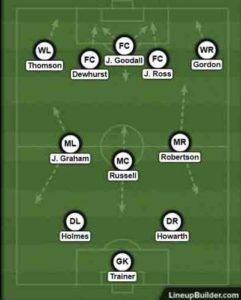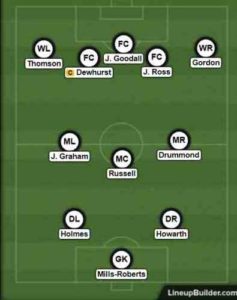In the wake of Manchester City’s record-breaking claim to the Premier League, The False 9 will look back at some of the greatest club sides to ever win the top tier of English football. Studying tactical nuances and squad strengths, the articles in this series will consider some the famous campaigns which led great teams to glory.
ON April 17, 1888, in a four-storey hotel in the middle of Manchester, the top division of football was born. There, at the Royal Hotel, delegates from Accrington, Aston Villa, Blackburn, Bolton, Burnley, Derby County, Everton, Notts County, Preston, Stoke, West Brom and Wolves reached an agreement to form the Football League, with games beginning in September that year.
Featuring twelve teams from Lancashire and the Midlands, the inaugural competition was resoundingly won by Preston North End. In a run of 22 league games, Preston went unbeaten and collected the FA Cup alongside the league title, becoming the first English side to do the double, and, over a century before Arsène Wenger’s glory in 2004, the first English side to remain ‘invincible’ for an entire season.

In the early 1880s, during the nascent years of association football, the novelty of the game wore off and tensions began to mount. Local clubs were growing, and the chief issue of the period was professionalism: players earning a living by taking part. Whilst in the South, many of those involved saw it as a bit of athletic fun, for Northern players the demands of work imposing upon football prompted clubs to secretly pay them for their time.
The FA was initially opposed to professionalism but faced a backlash from Northern teams, who were increasingly taking the game seriously. One of those in fervent support of professionalism was William Sudell, a mill owner, officer in the territorial forces and the chairman of Preston North End.

Sudell is recognised as the driving force behind Preston North End’s early success, assuming the roles of chairman, secretary and manager. A former player at the club, Sudell retired from sport in his early twenties, and made his name for his work behind the scenes. Prior to his involvement, Preston flirted with rugby and cricket, but in 1880 the club voted to exclusively play football. Taking the reins, Sudell was one of the first managers to use a blackboard to illustrate his tactics, on the advice of touring Scottish lecturers. Sudell travelled extensively around Scotland to hand-pick his team, and to circumvent the FA’s law that only local players can be paid, he gave his squad part-time work in his mill to subsidise their careers. His dedication could be seen even in his dismissal from the club in 1895, imprisoned for three years for embezzling funds for North End from his own business.
Season Overview
The Football League kicked off in September 8, 1888, with Preston winning their first fixture 5-2 against Burnley at the Deepdale. League organisation was loose, with a table and points system not devised until the season was partly underway. From matchday one, the Lilywhites underwent a six-game winning streak, scoring 25 goals, until they were held 0-0 away at Accrington.
The goalless draw against Accrington would be the only game in which Preston failed to score, continuing to rack up 7-0 wins over Stoke and Notts County and 5-0 wins against Derby County and West Brom, the latter having notably snatched the FA Cup from Preston in the 1888 final. Sudell’s side would finish the league with 18 wins and four draws, scoring 74 goals and only conceding 15. With two points awarded for a win, and one for a draw, North End won the league with three games to spare and totalled 40 points, eleven more than runners-up Aston Villa.
In the FA Cup, Preston reached the final without conceding a single goal, cruising to a 3-0 victory against Wolverhampton Wanderers at the Kennington Oval to clinch the trophy.
Preston’s domination was unprecedented, if not expected, a product of their strong squad as much as Sudell’s managerial nous. Whilst Jonathan Wilson’s Inverting the Pyramid (2008) doesn’t go into detail about Preston’s ‘invincible’ season, he notes that most of their Scottish squad were professional ‘in all but name’ long before 1888. According to legend, the Preston side which turned out for the 1888 FA Cup final pompously asked the referee if they may pose with the trophy before the game, convinced that they would go on to win it anyway. Although the Lilywhites would lose to West Brom, the tale indicates their confidence in their own abilities, those which were confirmed by their successes a year later.
Shape
The early years of football are associated with ludicrously-high match scores. Indeed, Preston lay claim to the biggest win recorded in an FA Cup tie, beating Manchester club Hyde United 26-0 in 1887. The emphasis of Victorian football was undeniably placed on the forwards, with teams only relying on physicality to win the ball back. However, Sudell is recognised as fielding a more defensive side than his counterparts, opting for a 2-3-5 ‘pyramid’ instead of the rudimentary, top-heavy 2-2-6 formation.

Preston North End’s first XI, based on appearances and goals
The 2-3-5 became the most popular line-up in British football for over four decades, as Wilson claims. Two ‘full-backs’, an anachronism for any out-field player in defence, played ahead of the goalkeeper. Three ‘half-backs’ played in the middle of the park, with a central, more defensive-minded player flanked by two ‘wing-backs’, or wide midfielders. In the forward line, two wingers played extremely wide, bookending three centre-forwards.
Of course, no video footage exists of the ‘Old Invincibles’ in action during their unbeaten season, whilst written reports and spoken accounts often focus on the mythic qualities of the players. Although the information is patchy and anecdotal, it remains all that can be found alongside recorded statistics, and so a rough description of the team will be given based on what has been written before.
A look back at Liverpool’s treble winning 1983/84 season
In goal, Welsh ‘keeper Jimmy Trainer was regarded as the best in Britain, already established from his time at Wrexham and Bolton. Ahead of him, the two ‘Bobs’, Howarth and Holmes, usually made up the defensive line. Both were young men, 23 and 21 respectively, when Preston won the double. Holmes, a wing-back converted into a full-back, would later go on to captain England in a 6-0 win over Wales.

Preston North End 3-0 Wolverhampton Wanderers, FA Cup final, 30/3/89
A Scottish trio of Johnny Graham, Dave Russell and Sandy Robertson typically played in the centre of the pitch. As Wilson notes, by the 1880s the Scottish were renowned for their passing game; as the half-backs, situated between the defenders and the forwards, it would have been up to them to collect, recycle and distribute accordingly. Dave Russell had made a name as a hard-man, as well as an avid performer at his local music hall, and would play in the centre between Graham and Robertson, likely dropping back in between Holmes and Howarth like a modern no. 6 when the opposition was on the attack.
Graham and Robertson seemed to embody different traits to one another. Graham was, according to David Randall at the Independent, a tireless runner, able to hurl long throw-ins into the box for attackers to head. Sandy Robertson, meanwhile, moved to Arsenal in 1890 and was regarded by one contemporary journalist as an ‘artiste’, although the same writer claims that Robertson succumbed to alcoholism and was let go by Arsenal in 1892, later becoming an ocean liner steward. Like Russell, both Johnny Graham and Robertson may have been encouraged by Sudell to drop back to help the defence out if necessary, particularly when engaged with the five forwards of the opposing team.
The five forwards for Preston are the most well remembered of the ‘Old Invincibles’, chiefly due to their array of technical abilities and shared goal-scoring prowess. On the wings, Scots Sam Thomson and Jack Gordon were expected to dribble and cross, demands of the traditional winger. Fred Dewhurst and Jimmy Ross typically played as inside-forwards, either side of John Goodall in the centre. Dewhurst and Ross were sensational in the 1888/89 season, renowned for their ball-control and shooting; Dewhurst, a school teacher, would score twelve league goals, while Ross netted 19 in 21 appearances. Jimmy Ross was nicknamed ‘the Little Demon’; as a diminutive forward at 5’7”, the Edinburgh man used his lightning pace to run late into the box and finish.
In the centre, England international John Goodall was immeasurably important to the Lilywhites’ invincible run: he scored 21 goals in 21 games, including two hat-tricks. Alfie Potts Harmer describes Goodall as ‘British football’s first superstar’: a gentlemanly player with exceptional skills, calm temperament and a real sporting generalist, holdinh tenure as a county cricket player for Derby in the 1890s and as a player-manager at Watford F.C. and French club RC Roublaix in his later years.
As well as a knack for finding the goal, Goodall possessed quick feet and fantastic vision for a pass, supposedly setting up nearly as many goals as he grabbed. His transfer to Derby County F.C. in 1889 shocked the footballing world, and although Goodall would never win the league again, he was held in stead as the top player of his generation.
Despite having a fixed starting XI, Sudell was prompted to rotate due to absence and FA foreign player limits. Utility players such as Georgie Drummond, Archie Goodall and goalkeeper Dr Bob Mills-Roberts found themselves sharing game time in the league and the FA Cup.
With a star-studded line-up, coupled with Sudell’s tactical developments, Preston North End achieved a feat which would only be replicated 115 years later. Andy Wood and Jack Portley, among others, have tried to compare Sudell’s Preston with Wenger’s Arsenal. Arguably, with the difference in structure to the league, the proliferation of expert training and the invention of elastic shorts, the comparison is not tangibly possible; yet, even if it was, Wenger’s success would not diminish that of the 1888/89 Preston side. Not even Preston could replicate their own record-setting ways, as the club retained the league in 1890 with four losses but faced relegation only three years later. In its formative years, league football should have been a chaotic free-for-all; instead, Preston North End stepped up to the plate, and made it all look rather easy.










Recent Comments